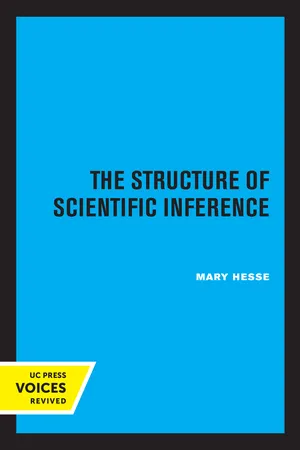
This is a test
- 318 pages
- English
- ePUB (mobile friendly)
- Available on iOS & Android
eBook - ePub
The Structure of Scientific Inference
Book details
Table of contents
Citations
About This Book
This title is part of UC Press's Voices Revived program, which commemorates University of California Press's mission to seek out and cultivate the brightest minds and give them voice, reach, and impact. Drawing on a backlist dating to 1893, Voices Revived makes high-quality, peer-reviewed scholarship accessible once again using print-on-demand technology. This title was originally published in 1974.
Frequently asked questions
At the moment all of our mobile-responsive ePub books are available to download via the app. Most of our PDFs are also available to download and we're working on making the final remaining ones downloadable now. Learn more here.
Both plans give you full access to the library and all of Perlego’s features. The only differences are the price and subscription period: With the annual plan you’ll save around 30% compared to 12 months on the monthly plan.
We are an online textbook subscription service, where you can get access to an entire online library for less than the price of a single book per month. With over 1 million books across 1000+ topics, we’ve got you covered! Learn more here.
Look out for the read-aloud symbol on your next book to see if you can listen to it. The read-aloud tool reads text aloud for you, highlighting the text as it is being read. You can pause it, speed it up and slow it down. Learn more here.
Yes, you can access The Structure of Scientific Inference by Mary Hesse in PDF and/or ePUB format, as well as other popular books in Biological Sciences & Science General. We have over one million books available in our catalogue for you to explore.
Information
Table of contents
- Cover
- Title
- Copyright
- Contents 1
- Acknowledgments
- Introduction THE TASK OF A LOGIC OF SCIENCE
- CHAPTER ONE Theory and Observation 1. Is there an independent observation language?
- II. Entrenchment
- III. The network model
- IV. Theoretical predicates
- V. Theories
- VI. Conclusion
- CHAPTER TWO A Network Model of Universals 1. The problem of universals
- II. The correspondence postulate
- III. Coherence conditions
- IV. Some epistemological consequences
- V. Meaning-change
- VI. Goodman’s strictures on similarity
- VII. Absolute universals again
- CHAPTER THREE The Grue Paradox I. Principles of solution
- II. Objective tests of ‘grue'
- III. Meaning variance and entrenchment
- CHAPTER FOUR The Logic of Induction as Explication I. Hume s legacy
- II. A more modest programme
- III. Probabilistic confirmation
- CHAPTER FIVE Personalist Probability I. Axioms and interpretation
- II. Bayesian methods
- III. Convergence of opinion
- IV. Non-Bayesian transformations
- V. Uncertain evidence
- CHAPTER SIX Bayesian Confirmation Theory I. The positive relevance criterion
- II. The transitivity paradox
- III. Suggested resolutions
- CHAPTER SEVEN Universal Generalizations I. Exchangeability and clustering
- II. The raven paradoxes
- III. Clustering in Carnap’s confirmation theory
- IV. Extension to analogical argument
- V. Causal laws and eliminative induction
- CHAPTER EIGHT Finiteness, Laws and Causality 1. The distribution of initial probabilities
- II. The probability of laws
- III. The necessity of laws
- CHAPTER NINE Theory as Analogy I. Some false moves: ‘acceptance’ and ‘explanation’
- II. Deduction from phenomena
- III. Whewell’s consilience of inductions
- IV. The analogical character of theories
- V. The function of models
- VI. Identification of theoretical predicates
- CHAPTER TEN Simplicity I. Subjective and notational simplicity
- II. Content
- III. Economy and clustering
- IV. The principle of relativity and classical electrodynamics
- V. Einstein’s logic of theory structure
- VI. Summary
- CHAPTER ELEVEN Maxwell’s Logic of Analogy I. Hypothetical, mathematical and analogical methods
- II. Experimental identifications
- III. The electrodynamic theory
- IV. Meaning variance and experimental identifications
- CHAPTER TWELVE A Realist Interpretation of Science I. The aims of science
- II. From naive realism to pluralism
- III. Realism and relativity
- IV. The cumulative character of science
- Index of Names
- Index of Subjects